Verona is most famous for its Roman Arena and as the setting for Shakespeare’s Romeo and Juliet. In addition, there are many wonderful things to love in this fair city.
Next to the Arena is one of the largest piazzas in Italy, Piazza Bra, with several main streets emanating from the central part of town. Via Mazzini is the most popular of the shopping streets in this pedestrian zone lined with shops and cafes, which is a major feature of town. It leads on to the Piazza delle Erbe, which had been the ancient Roman forum, and then the main square of Verona.
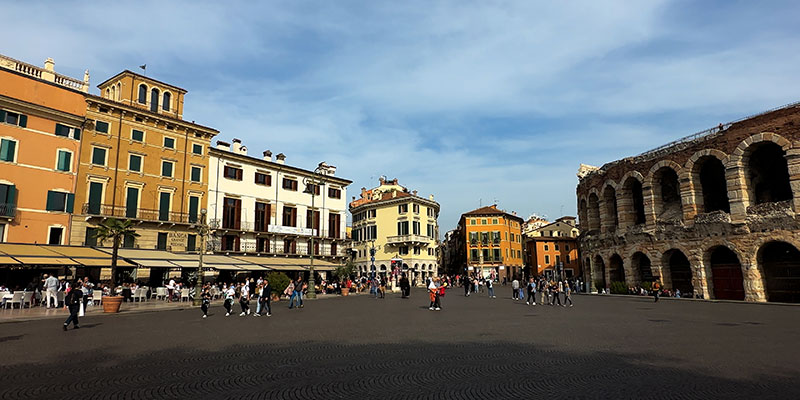
Verona is a UNESCO World Heritage site, partly because it's preserved the many ancient Roman monuments, including that magnificent Arena, and also because a massive earthquake in the year 1117 destroyed much of the city, which was then rebuilt in a Romanesque style. Many of those buildings still survive today. Verona is a place to linger. There are few locations in Italy where so many different periods of history are still illustrated. This is undoubtedly one of the loveliest cities of Europe.
We're taking you on a walking tour from one end of town to the other, up north to the Ponte Pietra, with two stone arches on the right side, built nearly 2000 years ago during the Roman period. The hill across the river on the left bank has a long history because it was here the first settlement of Verona was founded.
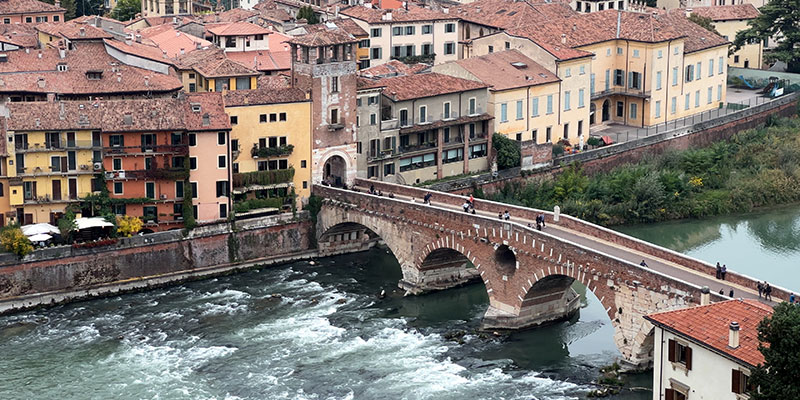
A fortress atop the hill offers the best vantage point for views across the whole city, where you can see how the Adige river wraps around the historic center, like a moat, yet this rapidly flowing river divides the town in two. Traversing the picturesque medieval bridge with a tower gateway at one end leads you back into the right bank, the main part of downtown.
We're going to take you on a walking tour through that historic center, to the bridge, the Duomo, and then coming down through some of the main streets, including Sant Anastasia and then back to the Arena. After that, we'll spend more time looking into several big churches and other historic sites.
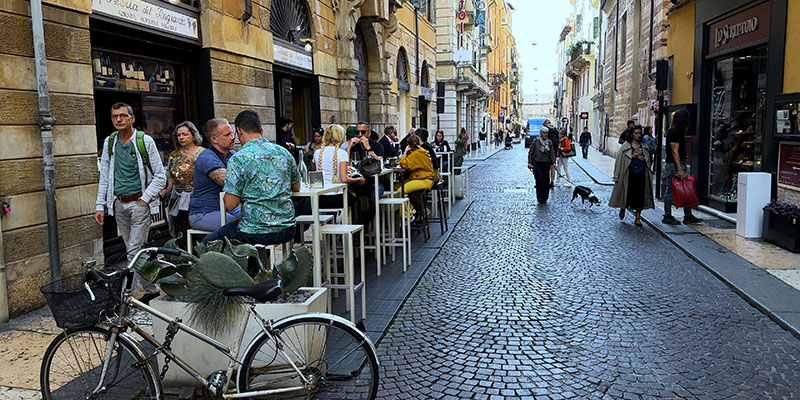
Typical of many Italian cities, the central part of town is for pedestrians. And when you get away from the tourist hotspots, you'll find little restaurants with a local atmosphere offering food at a very reasonable price. Some side streets do allow a few cars to come by, but overall, this is a wonderful pedestrian zone where you're free to walk without any danger of getting run over, and you can enjoy all of the shops and cafes and restaurants along the way.
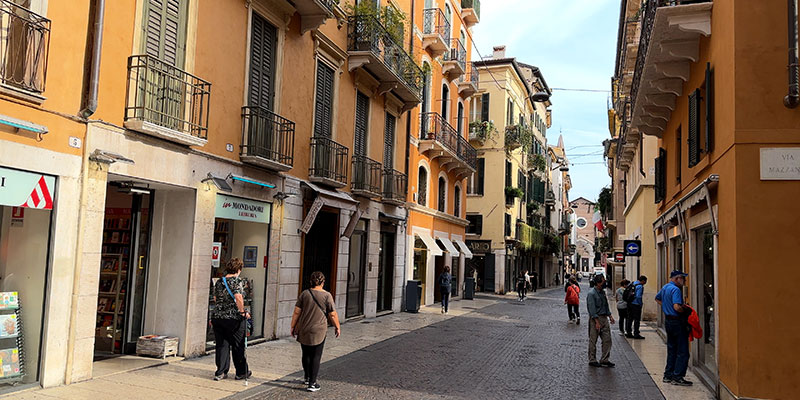
Corso Sant Anastasia follows the route of the main ancient Roman road called the Decumanus Massimo (the main east-west street), the oldest road in northern Italy. It started from Genova, passed through Verona and ended up near Trieste. It is still one of the main streets of the city, broad and level with the highest quality shops.
Some bakeries are so appealing you might want to get a dozen items. Fazzini cutlery has been in business here since 1897, offering the highest quality of knives, glasses, decanters and many more kitchen items. Our walking route passes the north end of Piazza delle Erbe, which we'll return to shortly. Here there are convenient sidewalk kiosks spilling out from the piazza.
About halfway along its length, Corso Sant Anastasia changes name to Corso Porta Borsari. There is an ancient Roman gateway or Porta, called Porta Borsari at the end of the road, which we saw while walking along with our local guide, Luca Mastella, who explained: "That was the outer side, but there was an interior courtyard, there where the chairs are with umbrellas. A gate, which was once in the past, a much bigger and much larger than nowadays."
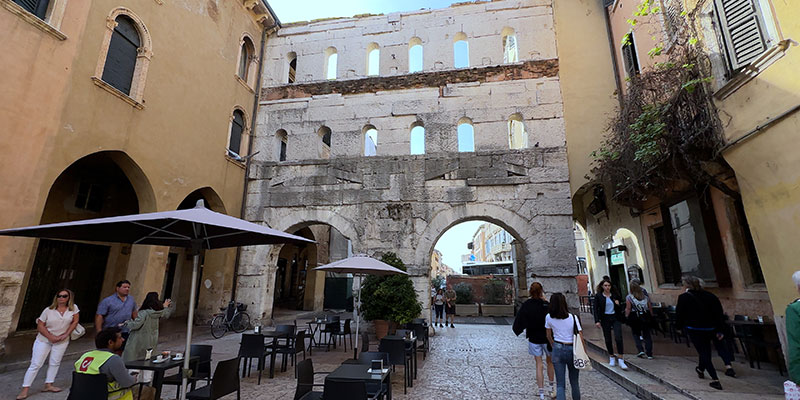
This impressive gate was built around 264 by the Roman Emperor Gallienus, forming part of the fortifications that the Romans built around the city. It was the chief Roman gate into ancient Verona. It's so well-preserved that we can view it from both sides. And the top level was probably built later in time with a slightly lower quality finish. Next to it small church converted into a pizzeria.
A block over at the river we get a fine view of Castelvecchio, constructed in the mid 14th century by the Scaliger dynasty that ruled the city in the Middle Ages. In the other direction we see Ponte della Vittoria, constructed in the 1920s, then blown up in World War Two, and rebuilt in the 1950s.
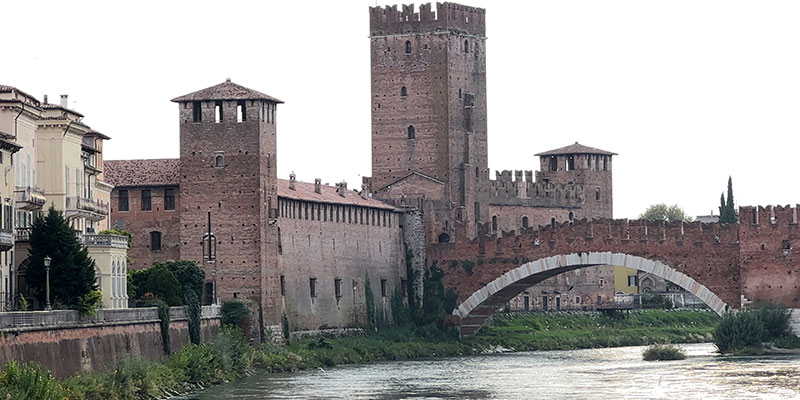
It leads back right into the middle of the Old Town. Here we find the hotel that I stayed at. A bit confusing, though, we're still in Verona, but it's called Hotel Bologna. Three stars located right around the corner from the Arena, also called the Amphitheater.
One of the great sights of the world is the Verona Amphitheater. It's amazing, especially at twilight, it's really quite dazzling. The building is about 2000 years old. It was the third largest Arena that the Romans ever built. And it's right here in the heart of Verona, beautifully preserved. You can go in during the day. You pay a slight admission fee, and it's worth it to have a look. They've got modern seats inside on top of the old marble benches. They use it for concerts. And it's just really one of the grandest structures that you'll ever run into. Its elliptical shape produces perfect acoustics from any standpoint and allows it to accommodate a large number of spectators. Built in the first half of the 1st century A.D., in the period which marked the end of the Augustus’s Empire and the beginning of Claudius.
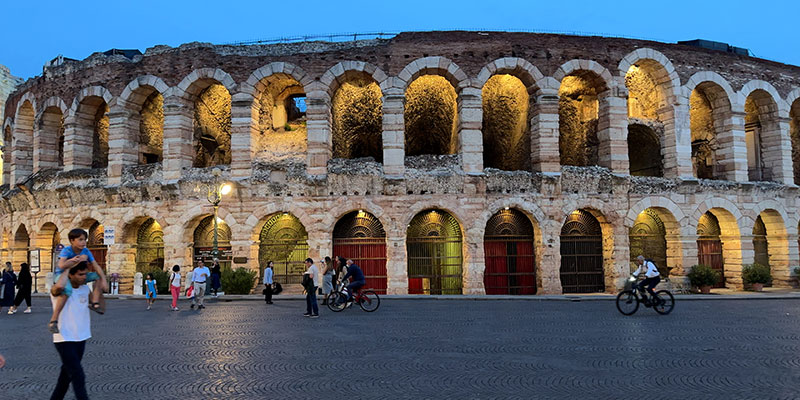
Originally constructed to host gladiator combats, the amphitheater saw a long period of abandonment before it returned to the limelight with a new form of entertainment, in 1913: after having hosted the premiere of Aida in that year, it has been known around the world for the sounds of opera that emanate from its stage, in addition to hosting concerts and theatre performances.
This could be reason enough to come to Verona just to see this Amphitheater. But there's many more things to see, of course, in this beautiful city. It's a wonderful place.
The Piazza Bra is one of the largest piazzas in all of Italy. There's a long row of restaurants which goes for several hundred meters, with wonderful outdoor places to eat. The most fashionable cafes are found in this piazza, making it an ideal place for that beloved drink, the spritz, along with a light snack or perhaps a full meal. It's also the main place in town for that evening traditional stroll, the passeggiata, so you are bound to see many locals here along with the visitors.
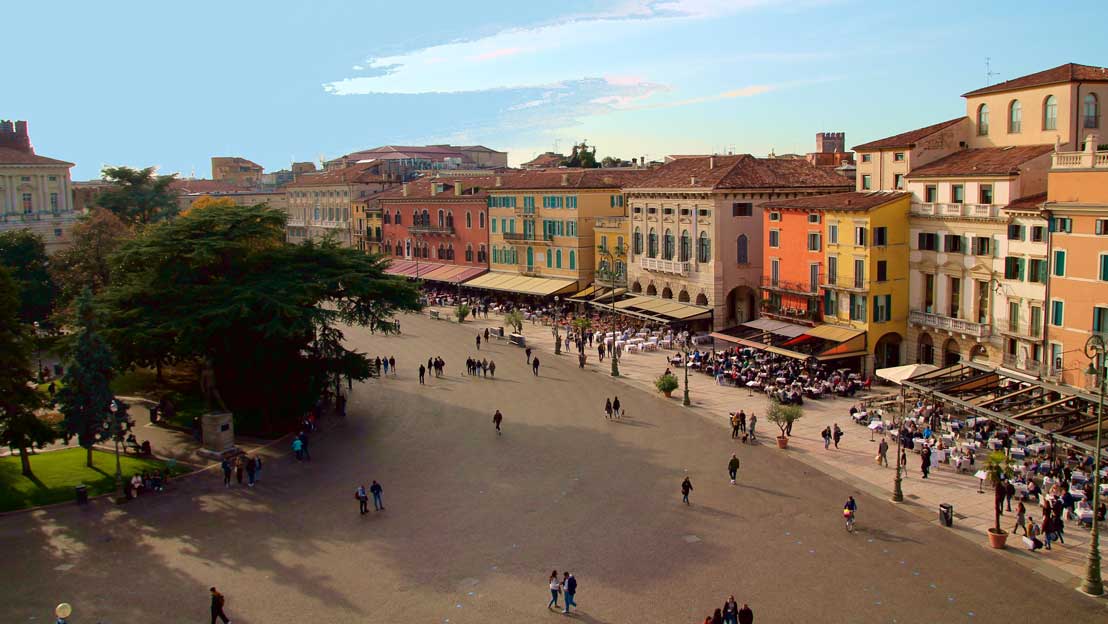
It's a wide-open space with a garden in the middle, shaded by cedar and pine trees, which are sheltering an equestrian bronze statue of the hero of the country, Victor Emmanuel Due, who led the unification of Italy.
If you don't feel like sitting down to a meal here, many of these restaurants have a little cafeteria counter where you can get sandwiches and other items as takeaway.
Next to the Amphitheater they have a graphic in the sidewalk that shows the ancient Roman street grid, typical of those Romans with straight lines. A similar grid of street pattern is still visible in Verona today.
The main shopping at street in Verona is via Mazzini. It goes from the Amphitheater all the way up to Piazza Erbe, practically, and it's full of the usual high end, glossy shops. And all the tourists come here, first of all. But there's many other little side streets where you're in Verona as we're showing you. It's so wonderful. The town has got authenticity galore. It's not just a tourist town. It's got the history with the Roman Amphitheater and Roman origins, and it's got the modern, glitzy shopping as well, and plenty of good places to eat.
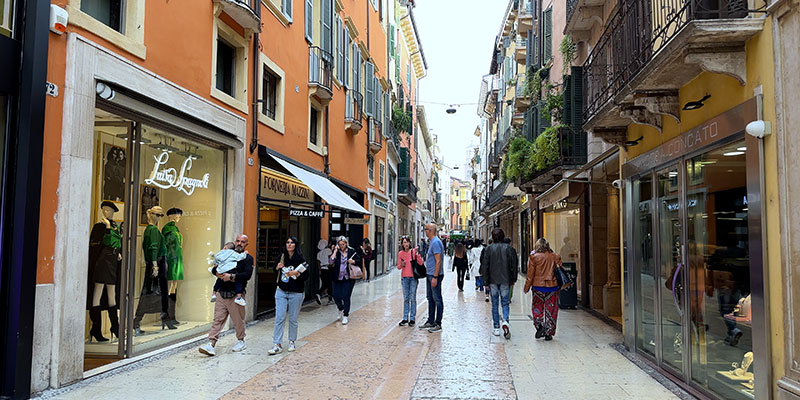
Notice the beautiful, smooth paving underfoot. You'll have no problem walking here. Not only is it level, there's no hills in the central part of Verona, but it is smooth. There are no cracks, and there's no broken pavement. You'll be very safe here in Verona, the city of marble and brick.
While Via Mazzini is one of those major streets that attracts lots of crowds because it has so many stores, cafes and restaurants open, other streets nearby are worth exploring as well. So now we're going to take you a few blocks over to the east of Via Mazzini into a more local neighborhood, so here you don't find so many tourists.
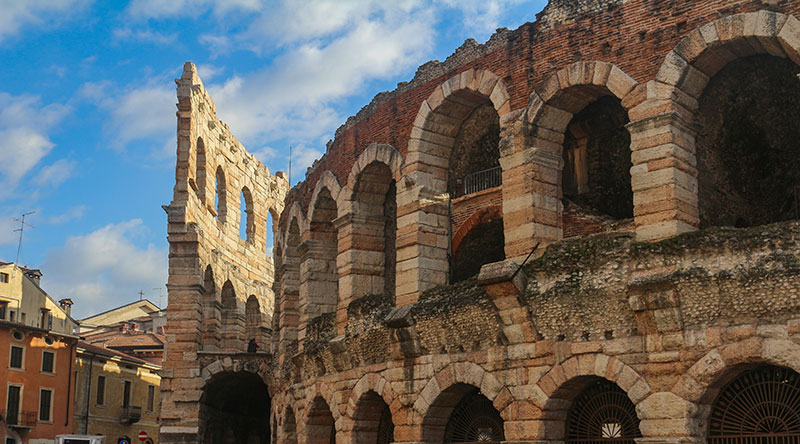
Most visitors only see the front of the Arena from Piazza Bra, but here we've gone behind the Arena where we can get a better look at the much higher outside wall that previously went all the way around, and better finished because they were meant to be seen on the outside. That wall previously had 72 arches, but now only four remain because of several earthquakes. The inner wall is built of huge roughened granite blocks.
The street behind the Arena called via Anfiteatro, leads us into a nice, quiet neighborhood where we find ourselves in Piazza san Nicolo, a place to walk the dog, where kids can come out and play. There are benches to just sit around and do nothing much but relax and enjoy the scene.
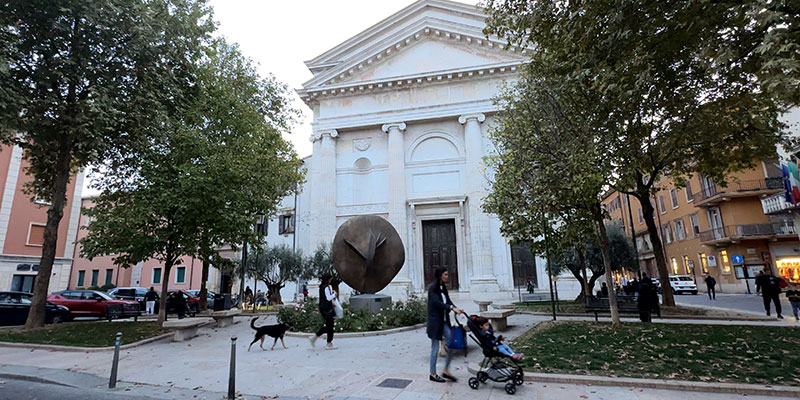
A big church, San Nicolo all'Arena, was built in the mid-in 17th century in the Baroque style. And our via Anfiteatro continues a few blocks north from here, a quiet residential zone, and a few shops. Then it changes names to Via Stella.
This was a nice discovery because here we have two blocks that are strictly for pedestrians. They're nice and wide, they've got restaurants and they are pretty much for locals because most tourists don't know about this street. This is a very nice place to have dinner.
Then around the corner at right angles, we find ourselves on via Scala, approaching an excellent hotel, the Accademia -- four stars, super quality with a nice little sidewalk cafe.
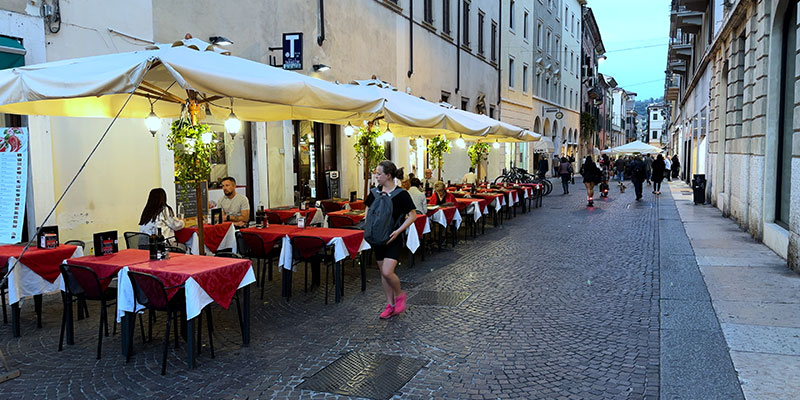
Via Scala connects with via Mazzini, where we began this little side trip, and then that connects on to via Capello, with the route that we've just taken, starting from the Arena shown on the map. This might be a good time to take a break for some gelato. It would be a good idea to recharge the batteries for some delicious gelato. After all that walking, it provides a delicious energy boost.
Continuing along via Capello brings us to one of the great sights of Verona, Casa di Giulietta, Juliet's House, an authentic palace of the 13th-century, with a reconstructed balcony. This is one of the most famous and most-visited places in the city of Verona.
The love story of Romeo and Juliet is said to have occurred in 1302. Shakespeare tells the story in the introductory lines of this tragedy:
"Two households both alike in dignity in fair Verona, where we lay our scene.
From ancient grudge break to new mutiny, where civil blood makes civil hands unclean. From forth the fatal loins of these two foes, a pair of star-crossed lovers take their life, whose misadventures piteous overthrows, do with their death, bury their parents' strife."
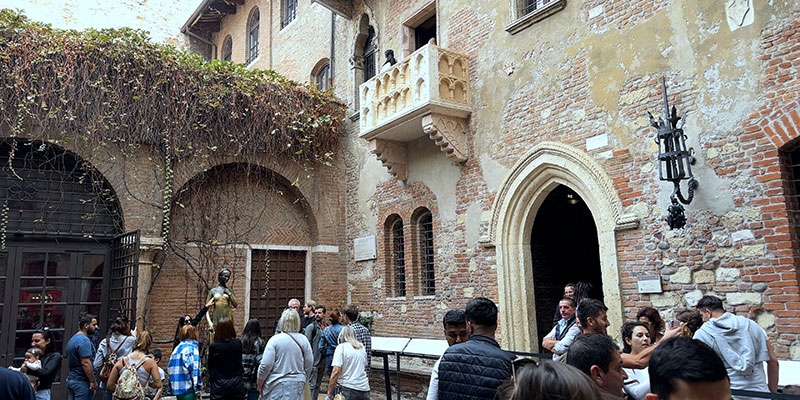
It is a perfect place to get those Instagram-ready photos. Little did the sculptor know that everybody would be rubbing up against the boob of Juliet and making it bright and shiny, with girls just as eager to touch to collect those social media trophies, compared to some guys who are somewhat indifferent. So you have not been to Verona until you have come here to Juliet's House and take your pictures of the statue and the balcony. Back out on the street of via Capello, which is really one of the nicest streets in town. It's perpendicular to the north end of via Mazzini, and it will lead you into another one of the main landmarks of Veron 's after you walk a couple more blocks past these enticing shops.
In recent centuries this piaza was the main open air vegetable market for the city, but has its origins back in ancient Rome, when it was the Roman Forum, the center of life in this Roman town nearly 2000 years ago. The square is framed by palaces and buildings that have marked the history of Verona.
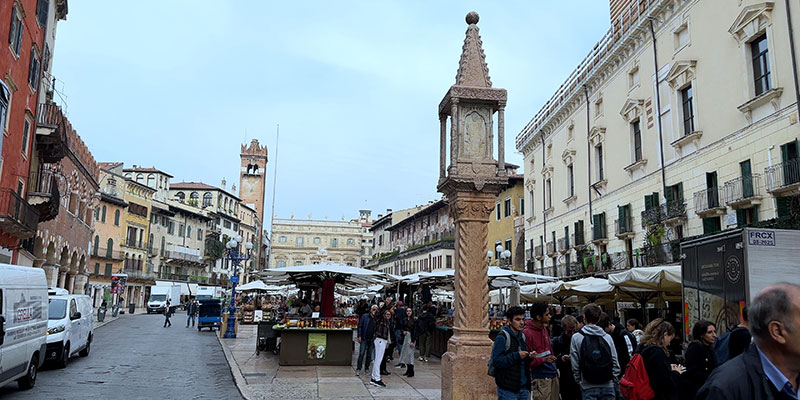
But now, like so many other market piazzas in Italy, it has become a souvenir stand with a tall forest of white umbrellas sheltering the space. And yet this piazza is still one of the most beautiful in the entire country, surrounded by spectacular buildings. One of them Casa Mazzanti, featuring a rare fresco on the outside, was painted by Alberto Cavalli about 500 years ago. Back in the 16th and 17th century, the facades of palaces in Verona were often entirely decorated with frescoes. It was a way to contribute to the decorum of the city and show off wealth and good taste. So common were these frescoes that the town was nicknamed "herbs picta" or Painted City.
The small open tribune in the center with its four columns marks the site where the Capitano del Popolo, the political leader, was publicly invested with his office and then addressed the people.
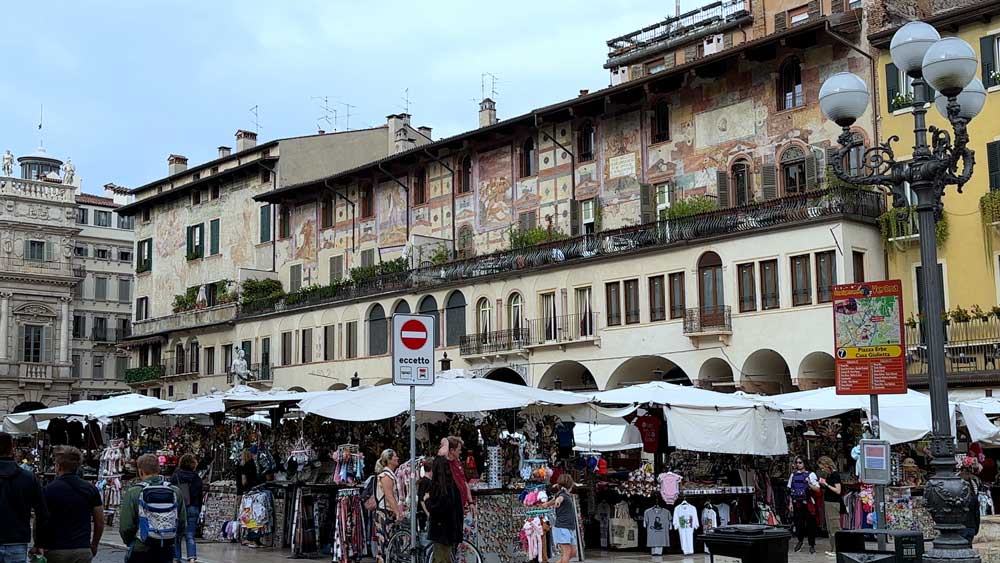
At the northern end stands the column of Saint Mark, bearing aloft the winged lion, which represented for so many years the dominion of Venice over the town of Verona. This mark of supremacy was destroyed in 1797, but in 1888 it was replaced again, no longer as a sign of submission, but as a graceful homage to their history.
That very tall Lamberti Tower was constructed in the year 1182. It's part of the 12th century Palazzo Della Ragione, one of the oldest public buildings in Italy that Rising high above it is a square tower made from brick reaching 84 meters high, whose marble octagonal belfry is now an observation deck reached by elevator. The marble fountain dates to the 10th-century with a statue of the so-called Madonna Verona, its water spilling over the edge.
Another architectural attraction of the piazza is the Casa de Mercanti. It dates from 1381, built in a fortified Romanesque style with rounded brick arches and alternate red and white stone, supported by heavy marble columns, built originally as a headquarters for local merchants. Now it's a bank.
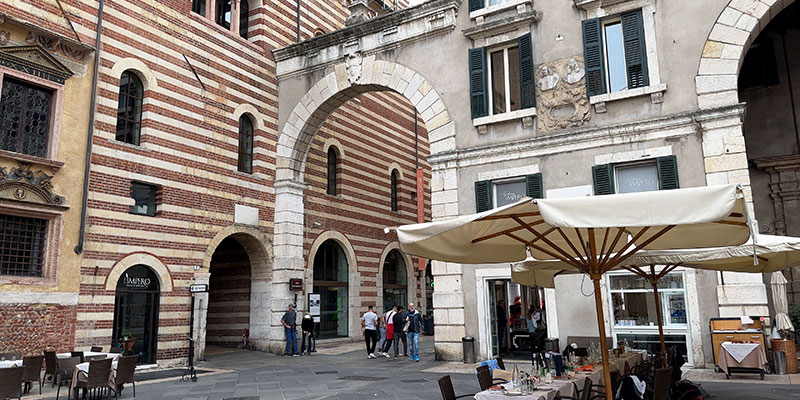
Just beyond Erbe is another very important Piazza dei Signori that can be entered through the arches that connect the two piazzas. With all of the delightful distractions of Piazza delle Erbe you might miss this opening between the buildings that leads into yet another important center of Verona. It is here where 16th-Century political life took place, while the Palazzo di Cansignorio and Palazzo del Comune (or della Ragione) were the seats of military, judicial and administrative power. Several palaces around Piazza de Signori had been home to the ruling Scaliger family, who are famous for the Gothic tombs they were interred in outside several nearby churches.
Piazza dei Signori is also called Piazza Dante, memorialized in a statue in front of a palace that Dante lived in after he was expelled from Florence, spending more time in Verona than at any other place. The piazza is enhanced by palaces of great historical and architectural importance, such as the Loggia of the Council, the Palace of the Government and the Domus Nova.
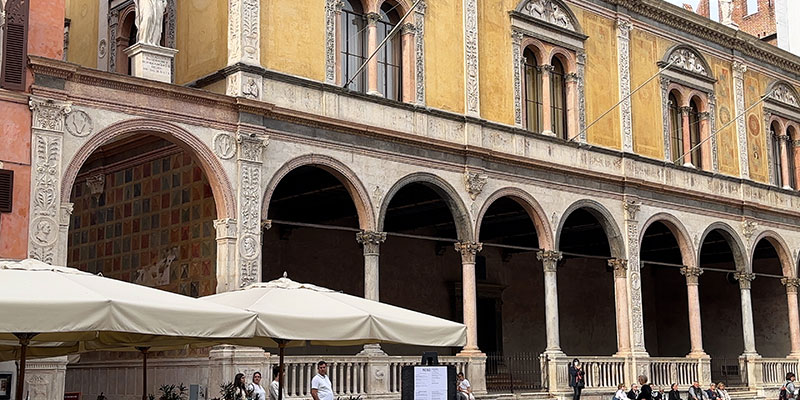
Palazzo Del Consiglio, built in a Renaissance style with Venetian influence in the loggia, was home to the ruling Scaglieri family back in the 15th and 16th centuries, who had several palaces on this piazza. There are not many open green parks in the historic center, so the local kids take over this historic piazza as their playground, tossing the ball around.
These elegant buildings are no longer private palaces, but instead have been converted to a variety of uses -- there are apartments, some have restaurants on the ground floor. And even though they're located right in the center of town next to Piazza delle Erbe, it's a little out of the way, so we have more of a calm local scene. And yet I'm guessing 90% of the tourists who go to Piazza delle Erbe never find this adjacent Piazza dei Signori.

There's even a small hotel here behind the Cafe Dante Bistro, the three star Albergo Mazzanti. We have a side view of that same Palazzo della Ragione that we saw earlier from the front on Piazza delle Erbe. Here too we see the fine architectural detail of the beautiful windows, the sculptural fragments and the high towers with alternation of red brick and white stone in the facade.
On the north side of the piazza, we reached the Church of Santa Maria Antica, remarkable for its tiny graveyard of elevated tombs, surrounded by exquisite trellises of wrought iron -- tombs of that all-powerful ruling Scaglieri family (a monumental funerary complex in Gothic style that hosts the final resting place of the Lords of Verona). There's a Gothic tomb over the door of the church of their greatest leader, Can Grande della Scala. The sarcophagus is sculpted with bas-reliefs represent the principal achievements of the warriors life, especially the siege of Vicenza.
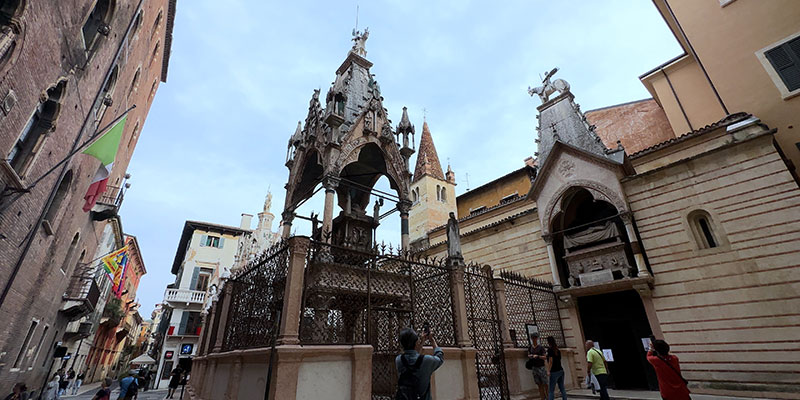
This Lord of Verona is laid in his long robe with his arms crossed upon his body and his sword by his side, with a stone canopy above. Dating from the 11th century, this little gothic church and graveyard is where the princes gathered and prayed. And in its small open yard, they sleep near the palace where they reigned. The 19th-century art historian, John Ruskin, called them the "consummate form of the Gothic tomb."
The beautiful and intricate iron grille forms a highly decorated fence that goes all the way around and protects this little graveyard. Notice that incorporated in the fence we have a recurring motif of the symbol of a ladder, which means Scala in Italian, and forms the icon of the Della Scala dynasty. The Romanesque church here is quite small because it was the private chapel of the Scaliger family.
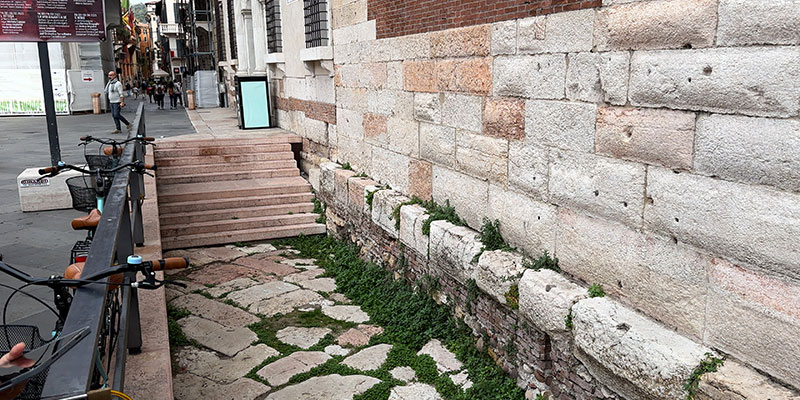
Nearby, we find another remnant of ancient Rome that's down well below the level of the city today, an ancient Roman road, with the original paving stones of a road that was used almost 2000 years ago. It's open to the public and you can actually walk down some steps, enter right into this road and walk on it yourself. Below the surface level of the current city, it's believed that many Roman structures are still there or two meters down beneath the surface. There is also an old mosaic floor paving, probably part of the palace of a wealthy family.
Just around the corner, we find Casa di Romeo, the supposed house of Romeo himself, in a building that dates back to the 13th century, which was the time of the famous play. Unlike Juliet's House, this one is not open to the public.
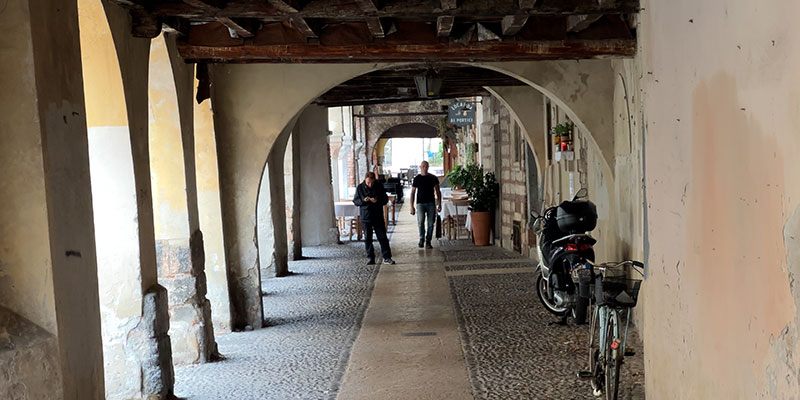
We're walking several blocks further north along these beautiful pedestrian streets lined with those ancient buildings. It's so picturesque, every place you turn in Verona. When you're in the historic center, it's one beautiful building after another. And then we come around the bend to via Sottoriva. This is one of the few examples of a street with a portico, which is a building extended across the sidewalk in an arcade held up by massive columns.
This is typical in other cities like Bologna especially, but in Verona, there are very few of these portico streets. We are not far from the river, and centuries ago this street was actually on the waterfront, a place where boats would arrive, passing through rivers and canals, arriving from Venice, for example, loaded with cargo. We've come across a luncheon celebrating somebody's graduation
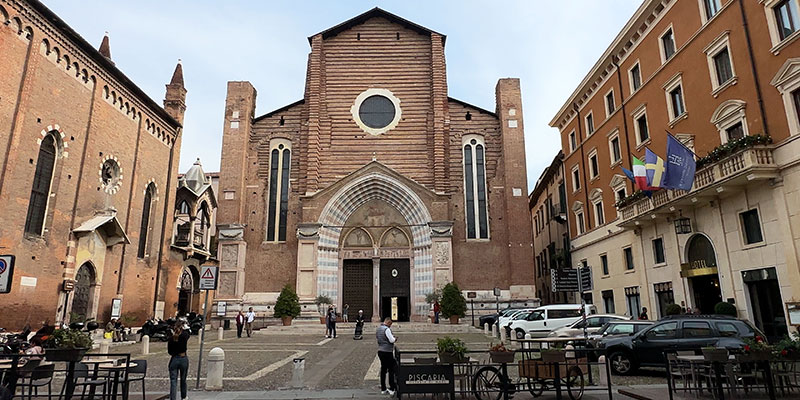
Continuing along via Sant Anastasia, we reached the church of the same name, a splendid example of Italian gothic architecture, inside which you can admire “S. Giorgio and the Princess”, a beautiful fresco by Pisanello (1433-38). The facade is still unfinished, but noble in its proportions. Sant Anastasia is one of the most perfectly beautiful Gothic buildings in Italy. The Dominicans built it in the 13th century. It's the largest church in Verona. A masterful example of the Italian Gothic style. It's a huge and lofty church built from 1290 to 1481 by the Dominicans to hold the massive congregations attracted by their sermons.
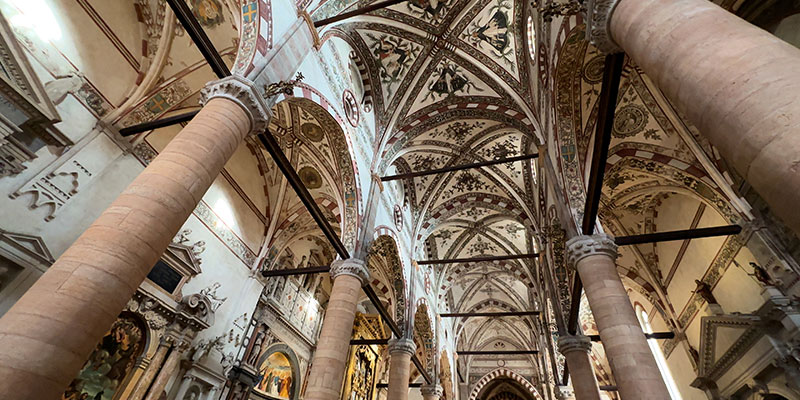
The interior is 300 feet long and 75 feet wide. Over the entrance to a courtyard by the side of the church, you'll see an impressive tomb which art historian Ruskin calls the "most perfect gothic monument in the world." It seems like it's magically supported in mid-air over the brick arch next to the Church of San Pietro Martirere.
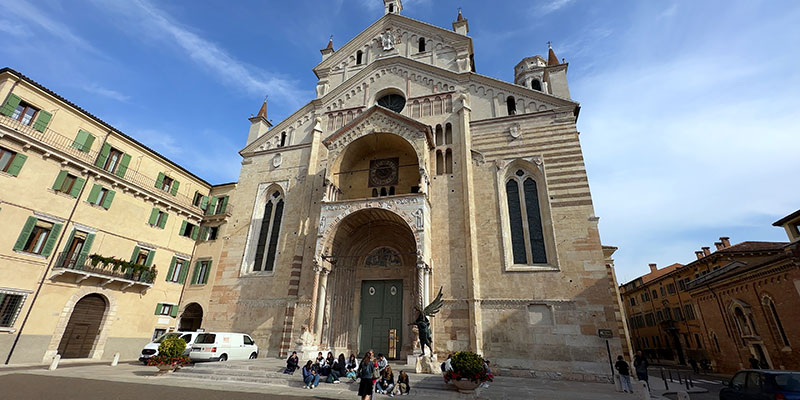
A few blocks away, we reached the Duomo, the great Cathedral of Verona. Tradition says that Charlemagne erected the first building on the site of the cathedral. The most ancient part that remains probably a portion of the first church is the apse, which on its exterior shows traces of Roman influence. The interior of the Duomo is gothic in this character, an excellent example of how that style of architecture was treated in Italy. The shape of the building is cruciform and supported by columns and capitals of different forms, all made of marble, either from Verona or from the East.
Charles Dickens visited here and loved the place. He said "Pleasant Verona, with its beautiful old palaces, with its marble-filled churches, rich architecture and prospects so delightful and cheerful, pleasant Verona." The quote is from a book Dickens wrote after his visit to Italy in 1844-45, called Pictures from Italy.
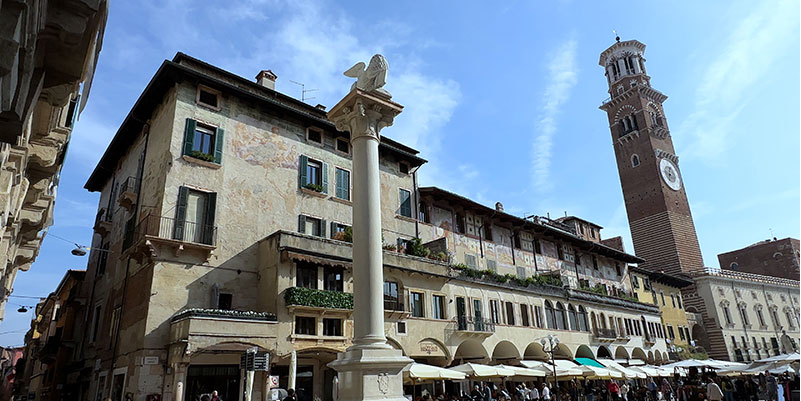
With over two millennia of history, Verona is currently the second city in Veneto in terms of the liveliness and consistency of its economic activities, and is also a popular international tourist destination.
Benefitting from its geographic location, it was probably home to a Rhaetian-Etruscan and Euganean town, but the first certain information dates back to the fourth century B.C.
It was a major political and commercial hub in Roman times (starting from the first century B.C.), and impressive traces of this legacy still remain, such as the famous Arena, the symbol of the city. In addition, it was also the capital of the Lombard Kingdom before Pavia.
Invaded and occupied for a significant length of time by the Barbarians, in the twelfth century, Verona’s history was marked by the foundation of the Free Comumne, an event that gave the city a new urban shape. Subsequently, in the second half of the thirteenth century, the city came to be dominated by the rule of the Scaliger, which retained its control over the territory of Verona until 1387.
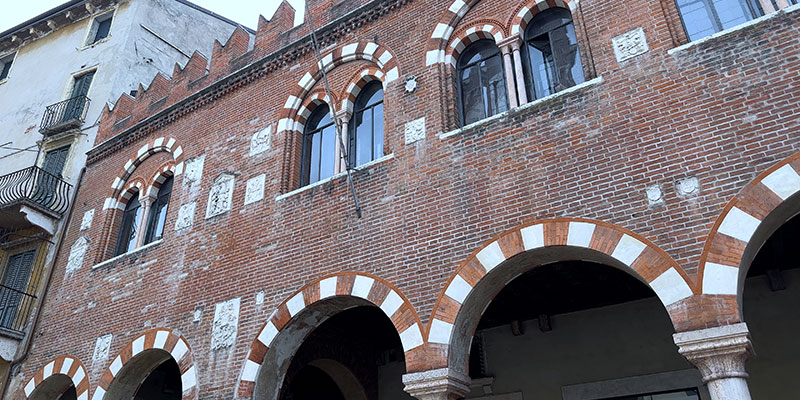
After a brief period under the Signoria of the Visconti and then of the Carraresi, power passed into the hands of the Republic of Venice, to which Verona was spontaneously delivered in 1405. The Serenissima led the city until 1796, when the territory was invaded by Napoleonic troops, which the Austro-Hungarian empire contested to gain hegemonic rule until 1815. After the Congress of Vienna, Verona was definitively ceded to Austria, which continued to control the city until 1866, when Verona was annexed to the newly formed Kingdom of Italy.
Watch the same video on the dedicated video page.